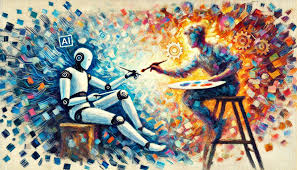
The Role of AI in Art Creation
AI's role in art has evolved significantly over the past few years. Through deep learning algorithms, neural networks, and natural language processing, machines have gained the ability to analyze, synthesize, and generate artistic content. Tools like OpenAI’s GPT-3, DALL·E, and Google's DeepDream are prime examples of how AI is transforming creative industries.
-
Music Composition: AI has been trained to compose original music by analyzing patterns in existing compositions. Programs like OpenAI’s MuseNet and Sony’s Flow Machines can generate music in various genres, imitating the styles of iconic composers like Beethoven, Mozart, or contemporary artists. But does this music resonate with human emotions in the same way? Can AI truly evoke feelings through sound, or is it just a technical exercise in pattern recognition?
-
Visual Arts: AI-generated artworks have made their mark in the art world. From paintings produced by algorithms to AI-driven pieces sold at auctions for millions of dollars, AI is becoming an established part of the contemporary art scene. Yet, critics argue that while these works may be visually stunning, they lack the true emotional depth that comes from an artist's lived experiences.
-
Literature and Poetry: AI systems have even been trained to generate poetry, short stories, and full-length novels. These works can be impressive in their coherence and structure, but can a machine truly capture the raw emotions behind the words? Poetry, often seen as a medium for expressing the complexities of the human soul, may be the hardest for AI to replicate authentically.
The Challenge of Emotion in Art
Emotion is at the heart of much of human creativity. Artists draw upon their life experiences, struggles, joys, and aspirations to create works that evoke powerful feelings in their audiences. But AI operates differently. It is a tool designed to process data and recognize patterns, not to experience life in the way humans do.
While AI can analyze vast amounts of data from existing works, including emotional responses tied to color choices in paintings or the tone in a piece of music, it cannot "feel" the emotions associated with the art it generates. It doesn't experience love, loss, anger, or joy—it simply simulates these feelings based on algorithms.
For example, AI music composition tools may recognize that a minor key tends to evoke sadness or that certain chord progressions are associated with happiness, but it doesn’t feel sadness or happiness itself. This distinction raises questions about whether AI can create art that genuinely resonates with human emotions or if it’s simply producing a technical imitation.
Can AI Understand Emotion in Art?
To understand if AI can truly grasp emotion and expression in art, we must first explore the nature of emotions themselves. Human emotions are deeply tied to subjective experiences—our memories, perceptions, and cultural contexts shape how we feel about a piece of art. These emotions are not just abstract concepts; they are lived experiences that are often conveyed through subtle nuances in an artist's brushstrokes, choice of words, or vocal inflections.
AI, however, lacks personal experiences. It doesn't have a history, a childhood, or the ability to perceive the world through human senses. It processes data, detects patterns, and predicts outcomes, but it cannot “live” the way we do. Therefore, while AI can simulate emotional expression through patterns—creating something that looks or sounds like a piece of emotionally-charged art—it lacks the true experiential foundation that human creators bring to the table.
AI can certainly help artists enhance their work by providing new tools for exploration and creativity. It can offer fresh perspectives or generate ideas that humans might not have thought of, but it is still a product of human input. AI's understanding of emotion is artificial, at best—rooted in data but devoid of the personal, human touch.
The Future of AI in Art
As AI continues to evolve, its potential in the arts grows ever more expansive. However, whether machines will ever "understand" emotion and expression in the same way humans do remains an open question.
AI's role in art could become more about collaboration than replacement. Artists could use AI to augment their creative process, blending human insight with the power of machines to push artistic boundaries. In this sense, AI may serve as a partner—an assistant capable of enhancing creativity, rather than a substitute for the emotional depth of human creation.
Moreover, as AI continues to evolve, it may develop more advanced ways to mimic emotional expression in art. Yet, even with these advances, the question remains: can AI ever truly understand the emotional weight behind a work of art, or will it always be a tool for us to use in our pursuit of self-expression?
Conclusion: The Human Touch
Ultimately, while AI has proven itself capable of creating remarkable works of art, it is important to remember that the human experience is what breathes true meaning into art. AI may be able to mimic expression and generate beautiful pieces, but it will always be the human spirit—the emotions, experiences, and stories we carry with us—that will define the true essence of art.
The future of art and AI may not be about replacing human creativity, but rather enhancing it. As artists and technologists continue to experiment with AI, we may find that the most powerful art is not one created by a machine alone but one that marries human emotion with technological innovation.
AI may not feel, but through our use of it, it can help us express what is beyond our own capabilities. It is through this collaboration that the future of art—and emotion—may truly unfold.